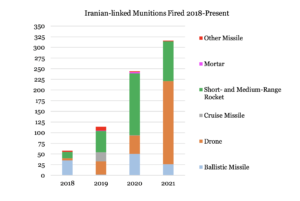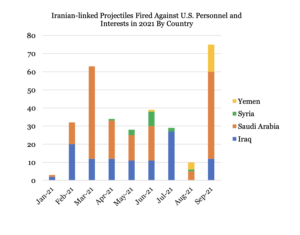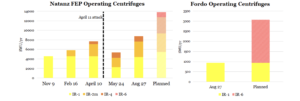Iran Summary – September 2021
About the Iran Update: The Jewish Institute for National Security of America’s (JINSA) Gemunder Center has started a monthly tracker providing timely information and graphics illustrating Iran’s aggressive and destabilizing activities.
September 2021 Summary: After several months of relative calm, the first full month in power for new Iranian President Ebrahim Raisi saw a return to Iranian aggression and escalation in multiple arenas. Despite signals that Iran might soon return to nuclear talks, it continued expanding its nuclear program—particularly increasing its use of advanced centrifuges—while blocking international inspectors. Iran and its regional militias launched an unprecedented number of rockets, missiles, and drones at U.S. service members, partners, and interests during September.
UN General Assembly: President Raisi heavily criticized U.S. sanctions on Iran during his first speech at the UN since taking office, offering a much more hostile attitude than his predecessor, Hassan Rouhani.
- “Sanctions are the U.S.’ new way of war with the nations of the world” and imposing such measures during COVID-19 is constitutes “crimes against humanity.”
- On U.S. withdrawal from Afghanistan:
- “From the Capitol to Kabul, one clear message was sent to the world: the U.S.’ hegemonic system has no credibility, whether inside or outside the country.”
- “The project of imposing Westernized identity” has failed, and “today, the U.S. does not get to exit Iraq and Afghanistan but is expelled.
- Raisi did not eliminate the prospects of returning to the nuclear agreement but stated “we don’t trust the promises made by the U.S. government.”
Regional Aggression: After a relatively quiet August, Iranian-backed militias launched more munitions during September than any month since at least 2018. While air defenses intercepted most of the projectiles, these threats caused several casualties and damaged infrastructure. The large escalation in violence went largely unanswered, which Iran and its proxies will likely interpret as a sign that their aggressive activities will not trigger deterrent military action from the United States.
- Iranian-backed groups, particularly the Houthis in Yemen, launched seventy-five munitions during September against critical interests such as cities, oil facilities, ports, and airports. These attacks included sixty-three drones, by far the largest number since 2018, according to JINSA’s Iran Projectile Tracker. Sixty-two percent of the munitions that Iranian-linked militias have fired this year have been drones compared to just nineteen percent between 2018-2020.
- The 316 projectiles that Iranian-backed groups have fired in 2021 already surpasses the 244 recorded in 2020.
- The IRGC attacked Iraqi Kurdish positions in Erbil province using drones, artillery, airstrikes on September 9.
- On September 25, Houthi ballistic missiles hit celebrations in Midi, Yemen, killing 5 and wounding 17.


Nuclear: Despite attention-grabbing progress in its enrichment of 20 and 60 percent uranium, Iran’s most important advances toward a nuclear weapons capability in the near-term will likely come from its research and deployment of thousands of new, much more efficient centrifuges. JINSA assesses that if Iran follows through on plans to expand its enrichment facilities, its breakout time to produce enough fissile material for a nuclear weapon could be well under one month
- Data from the International Atomic Energy Agency’s (IAEA) quarterly report on Iran’s nuclear program released on September 7 indicates dangerous trends:
- Persistent growth of 20 percent and 60 percent enriched uranium stockpiles;
- Continuing installation of additional centrifuges at Natanz and Fordo facilities;
- Increasing research and development (R&D) of advanced centrifuges; and
- An alarmingly short “breakout” timeframe for Iran to enrich enough fissile material for a nuclear weapon, which could be as little as one month.
- After blocking legally mandated inspections of its nuclear facilities since February 2021, on September 12, Iran reached an agreement with the IAEA to grant it minimal access.
- The agreement is one-sided, undermining the broader nonproliferation regime and decreasing intelligence about Iran’s nuclear program as it shortens its breakout time to a bomb.
- By September 27, Iran violated this agreement, denying inspectors access to a critical centrifuge assembly plant.
- On September 14, Iran’s parliament approved Ali Bagheri Kani, a hardline senior diplomat and relative of Ayatollah Khamenei, as Deputy Foreign Minister. Kani could take over as chief nuclear negotiator.
- Foreign Minister Hossein Amir-Abdollahian told reporters at the UN General Assembly that “the Islamic Republic of Iran will return to the table of negotiations. We are reviewing the Vienna negotiations files currently and, very soon, Iran’s negotiations with the ‘four plus one’ countries will recommence.”


Human Rights:
- The United States sanctioned our Iranian intelligence operatives in early September who were behind the plot to kidnap Iranian-American journalist Masih Alinejad.
- Iranian teachers held several nationwide protests in September as the new school year approached demanding higher wages. The current minimum wage for teachers in Iran is 35 million rials, about $1,500 USD per year.
- While the Iranian regime faced nationwide protests this summer over water shortages and government corruption, teachers have been protesting across the country since last year. Teachers have also been increasingly committing suicide in Iran, including several incidents during September.